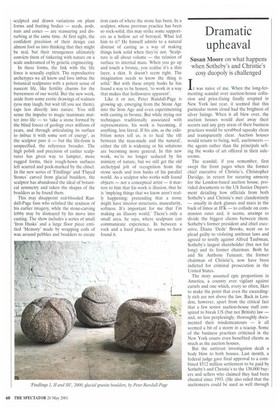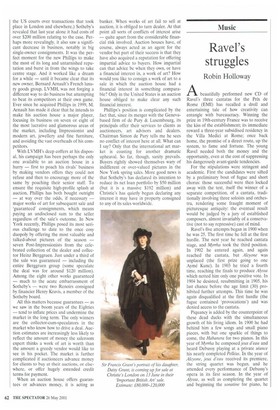Dramatic upheaval
Susan Moore on what happens when Sotheby's and Christie's cosy duopoly is challenged
It was naive of me. When the long-fermenting scandal over auction-house collusion and price-fixing finally erupted in New York last year, it seemed that this particular storm cloud had the brightest of silver linings. When it all blew over, the auction houses would dust away their secrets and any grey areas of their business practices would be scrubbed squeaky clean and transparently clear. Auction houses would return to being, well, auctioneers — the agents rather than the principals selling the works of art offered in their salerooms.
The scandal, if you remember, first swept the front pages when the former chief executive of Christie's, Christopher Davidge, in return for securing amnesty for the London-based auction house, provided documents to the US Justice Department detailing how officials from both Sotheby's and Christie's met clandestinely — usually in dark glasses and macs in the back of limos at JFK — to collude on commission rates and, it seems, attempt to divide the biggest clients between them. Sotheby's former president and chief executive, Diana `Dede' Brooks, went on to plead guilty to violating antitrust laws and agreed to testify against Alfred Taubman, Sotheby's largest shareholder (but not for long) and its former chairman. Both he and Sir Anthony Tennant, the former chairman of Christie's, now have been indicted for criminal prosecution in the United States.
The story assumed epic proportions in America, a country ever vigilant against cartels and one which, every so often, likes to make the point that even the exceedingly rich are not above the law. Back in London, however, apart from the critical fact that a few senior auction-house staff conspired to break US (but not British) law — and, no less perplexingly, thoroughly documented their misdemeanours — it all seemed a bit of a storm in a teacup. Some of the business practices criticised in the New York courts even benefited clients as much as the auction houses.
But the antitrust investigation dealt a body blow to both houses. Last month, a federal judge gave final approval to a combined $512 million settlement to be paid by Sotheby's and Christie's to the 130,000 buyers and sellers who claimed they had been cheated since 1993. (He also ruled that the auctioneers could be sued as well through the US courts over transactions that took place in London and elsewhere.) Sotheby's revealed that last year alone it had costs of over $200 million relating to the case. Perhaps more revealingly, it also saw a significant decrease in business, notably in big single-owner consignments. It was the perfect moment for the new Phillips to make the most of its long and untarnished reputation and burst in from the wings to take centre stage. And it worked like a dream for a while — until it became clear that its new owner, Bernard Arnault's French luxury goods group, LVMH, was not forging a different way to do business but attempting to beat its competitors at their own game. Ever since he acquired Phillips in 1999, M. Arnault has made it clear that he intends to make his auction house a major player, focusing its business on seven or eight of the most lucrative and glamorous areas of the market, including Impressionist and modern art, jewellery and fine furniture, and avoiding the vast overheads of his competitors.
With LVMH's deep coffers at his disposal, his campaign has been perhaps the only one available to an auction house in a hurry — first to poach his rivals' business by making vendors offers they could not refuse and then to encourage more of the same by poaching their senior staff. To ensure the requisite high-profile splash at auction, Phillips has both bought outright — at way over the odds, if necessary — major works of art for subsequent sale and 'guaranteed' consignments, which means paying an undisclosed sum to the seller regardless of the sale's outcome. In New York recently, Phillips posed its most serious challenge to date to the once cosy duopoly by offering the most valuable and talked-about pictures of the season — seven Post-Impressionists from the celebrated collection of the dealer and collector Heinz Berggruen. Just under a third of the sale was guaranteed — including the entire Berggruen group (some speculate the deal was for around $120 million). Among the eight other works guaranteed — much to the acute embarrassment of Sotheby's — were two Renoirs consigned by financier Henry Kravis, a member of the Sotheby board.
All this matters because guarantees — as we saw in the boom years of the Eighties — tend to inflate prices and undermine the market in the long term. The only winners are the collector-cum-speculators in the market who know how to drive a deal. Auction estimates are increasingly less likely to reflect the amount of money the saleroom expert thinks a work of art is worth than the amount a greedy vendor would like to see in his pocket. The market is further complicated if auctioneers advance money for clients to buy at their auctions, or elsewhere, or offer hugely extended credit terms for payment.
When an auction house offers guarantees or advances money, it is acting as banker. When works of art fail to sell at auction, it is obliged to turn dealer. At that point all sorts of conflicts of interest arise — quite apart from the considerable financial risk involved. Auction houses have, of course, always acted as an agent for the vendor but part of their success is that they have also acquired a reputation for offering impartial advice to buyers. How impartial can that advice be when they own, or have a financial interest in, a work of art? How would you like to consign a work of art to a sale in which the auction house had a financial interest in something comparable? Only in the United States is an auction house obliged to make clear any such financial interest.
Phillips's position is complicated by the fact that, since its merger with the Genevabased firm of de Fury & Luxembourg, its principals offer their services to clients as auctioneers, art advisors and dealers. Chairman Simon de Fury tells me he sees no conflict of interest here at all. What can say? Only that the international art market is coasting for another dramatic upheaval. So far, though, sanity prevails. Buyers rightly showed themselves wary of indifferent or over-valued pictures in the New York spring sales. More good news is that Sotheby's has declared its intention to reduce its net loan portfolio by $50 million (but it is a massive $192 million) and Christie's has quietly begun declaring any interest it may have in property consigned to any of its sales worldwide.



















































































 Previous page
Previous page